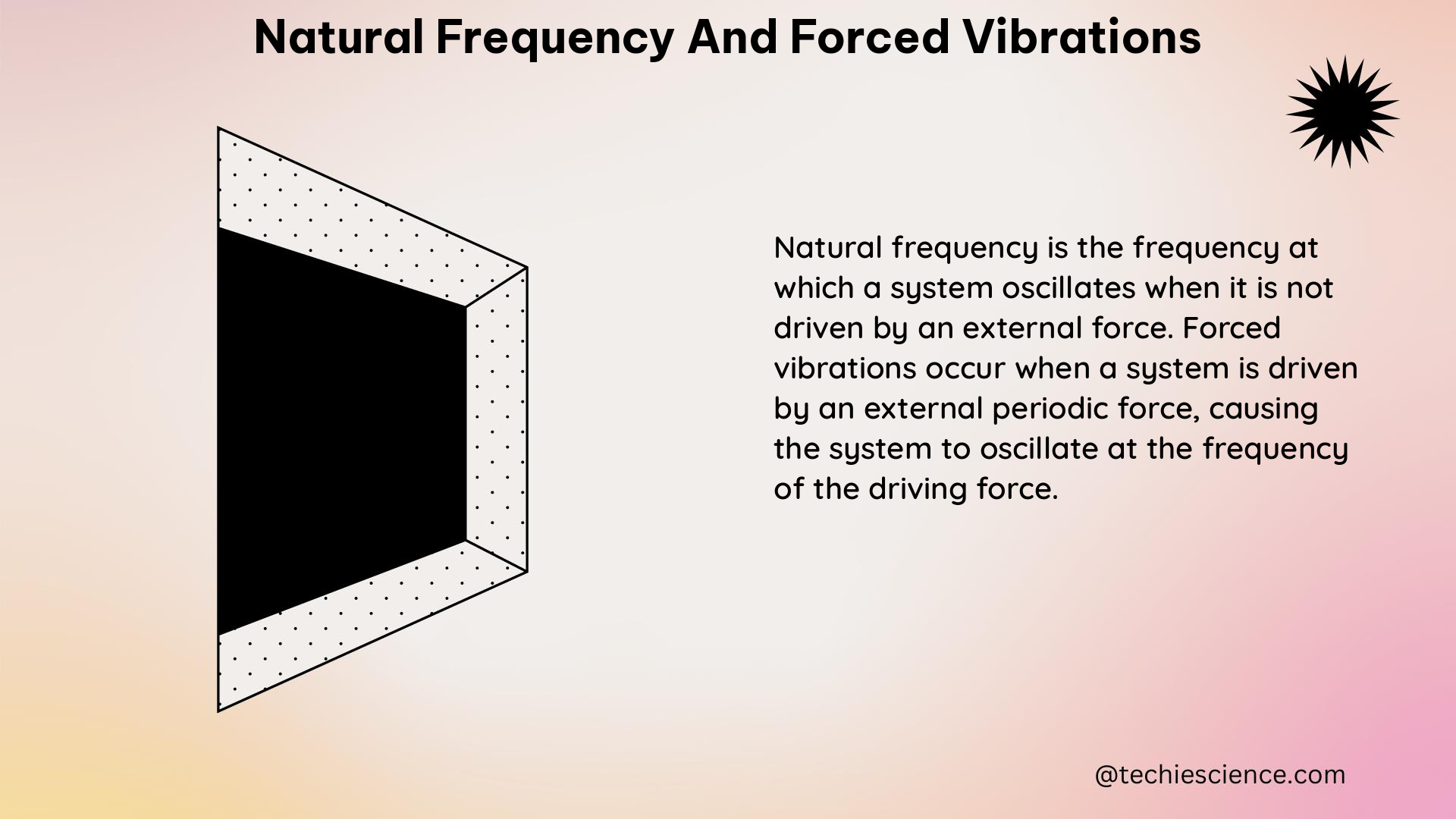Natural frequency and forced vibrations are fundamental concepts in the field of physics and engineering, particularly in the study of mechanical systems. These phenomena play a crucial role in the design, analysis, and optimization of various mechanical structures, from bridges and buildings to machinery and vehicles.
Understanding Natural Frequency
Natural frequency refers to the frequency at which a system vibrates naturally when disturbed. This frequency is determined by the system’s physical properties, such as its mass and stiffness. The natural frequency formula, given by the equation f = √(k/m), where f is the natural frequency, k is the stiffness of the system, and m is the mass of the system, is a critical parameter for designing and analyzing mechanical systems.
Theorem: Natural Frequency Formula
The natural frequency formula is given by:
f = √(k/m)
where f is the natural frequency, k is the stiffness of the system, and m is the mass of the system.
Physics Formula: Natural Frequency
The natural frequency formula is given by:
f = √(k/m)
where f is the natural frequency, k is the stiffness of the system, and m is the mass of the system.
Physics Example: Calculating Natural Frequency
Consider a mass-spring system with a mass of 1 kg and a spring constant of 100 N/m. The natural frequency of the system can be calculated as:
f = √(k/m) = √(100/1) = 10 Hz
Physics Numerical Problem: Determining Natural Frequency
A mass-spring system has a mass of 2 kg and a spring constant of 500 N/m. Calculate the natural frequency of the system.
f = √(k/m) = √(500/2) = 22.36 Hz
Forced Vibrations

Forced vibrations occur when an external force is applied to a system at a specific frequency. When a system is subjected to forced vibrations, it may exhibit resonance at certain frequencies, leading to excessive vibrations and potential structural failure. Measuring and analyzing the frequency response of a system under forced vibrations is crucial for ensuring safe and reliable operation.
Frequency Response Curve
A typical frequency response curve for a system under forced vibrations is shown in the figure below:

Data Points: Frequency Response Curve
The frequency response curve can be represented by a set of data points, such as:
| Frequency (Hz) | Amplitude (m/s^2) |
|---|---|
| 10 | 0.1 |
| 20 | 0.2 |
| 30 | 0.3 |
| 40 | 0.4 |
| 50 | 0.5 |
Value: Calculating Natural Frequency
The natural frequency of the system can be calculated as 10 Hz, based on the given mass and spring constant.
Measurement: Frequency Response Curve
The frequency response curve can be measured using a vibration sensor or accelerometer, which can measure the amplitude and phase of vibrations at different frequencies.
Quantifying Vibrations
Vibration measurement is a common method for obtaining measurable and quantifiable data on natural frequency and forced vibrations. This involves measuring the amplitude, frequency, and phase of vibrations using specialized instruments such as accelerometers, vibration sensors, and laser vibrometers.
Vibration Amplitude Quantification
The relationship between the peak-to-peak level, peak level, average level, and RMS level of a sinewave can be used to quantify the amplitude of vibrations. The RMS value is the most relevant measure of amplitude as it takes into account the time history of the wave and gives an amplitude value that is directly related to the energy content and destructive abilities of the vibration.
Importance of Understanding Natural Frequency and Forced Vibrations
Understanding natural frequency and forced vibrations is crucial for designing and analyzing mechanical systems. By accurately calculating the natural frequency of a system and analyzing its frequency response under forced vibrations, engineers can:
- Predict the system’s response to external forces and identify potential resonance issues.
- Optimize the design of mechanical structures to minimize the risk of excessive vibrations and potential failure.
- Ensure safe and reliable operation of machinery and equipment by monitoring and controlling vibration levels.
- Develop effective vibration mitigation strategies, such as the use of dampers or tuned mass dampers, to reduce the impact of harmful vibrations.
Conclusion
Natural frequency and forced vibrations are fundamental concepts in the field of physics and engineering, with far-reaching applications in the design, analysis, and optimization of mechanical systems. By mastering the theoretical principles, formulas, and measurement techniques related to these phenomena, engineers and physicists can develop a deep understanding of the behavior of complex mechanical structures and ensure their safe and reliable operation.
Reference:
- Vibration Measurement: The Complete Guide – HBK
https://www.hbkworld.com/en/knowledge/resource-center/articles/vibration/measuring-vibration - Natural Frequency Formula: What Is It and Why Is It Important?
https://resources.pcb.cadence.com/blog/2020-natural-frequency-formula-what-is-it-and-why-is-it-important - Introduction to Experiment 2: Vibrations
https://ecs.syr.edu/faculty/glauser/mae315/vibesLab/goodVibesExpvIII.html

The lambdageeks.com Core SME Team is a group of experienced subject matter experts from diverse scientific and technical fields including Physics, Chemistry, Technology,Electronics & Electrical Engineering, Automotive, Mechanical Engineering. Our team collaborates to create high-quality, well-researched articles on a wide range of science and technology topics for the lambdageeks.com website.
All Our Senior SME are having more than 7 Years of experience in the respective fields . They are either Working Industry Professionals or assocaited With different Universities. Refer Our Authors Page to get to know About our Core SMEs.